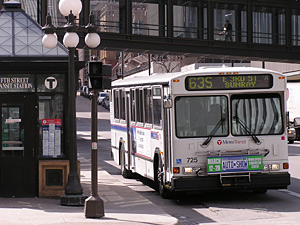Audio
Photos
More from MPR
| ||||||||||||||||||||||||||||||||||||
July 11, 2005
Minnesota lawmakers found money to make up some of the projected revenue shortfall facing Twin Cities transit service. Overall, lawmakers say, transportation spending on the state's aging road and bridge system will remain largely unchanged. The budget agreement contains no increase in the state gasoline tax, license tab fees, or other sources of revenue that could help fix what many say is a deficient state transportation system.
St. Paul, Minn. — Interest groups from across the political spectrum entered this year's legislative session with ambitious proposals for new transportation projects and high hopes for increased transportation funding. The proposed state budge agreement contains almost none of the provisions.
The result, says Senate Transportation Committee Chair Steve Murphy, DFL-Red Wing, is that spending on Minnesota's roads, bridges, and transit lines will remain largely unchanged. In fact, there is a chance that tax revenues used to fund the system may decline. Murphy predicts that rising gasoline prices will cause motorists to cut back on driving.
Revenue officials are counting on the state's growing population and the increasing number of vehicles on the road to bring in three percent more gas tax revenue each year. Murphy doesn't believe it.
"I think next year it'll be less than that because when you've got $2.20, $2.30 gas people are going to find better ways to use that gas so they stretch it out," he said.
Lawmakers carved out $46 million from the state's general fund to help fill a transit funding hole. Six million dollars go to completely erase the projected shortfall for transit systems across the state of Minnesota. Forty million dollars are earmarked to fill a $60 million shortfall in the Twin Cities Metro Transit system.
Earlier this year the Metropolitan Council, which operates the majority of the Twin Cities transit system, said revenue was down. Part of the reason is that Minnesotans are not buying as many new cars as had been projected. Just under half of Metro Transit's revenue comes from the state's vehicle sales tax.
Metro Transit head Brian Lamb says the new transit funds will take care of about two-thirds of the projected revenue shortfall. The amount is still not enough, Lamb says, to allow the agency to roll back a 25 cent fare increase or to restore recent service cuts.
Movever, Lamb says, the funding problem remains.
"So far in 2005 the motor vehicle sales tax revenues actually received are lower than the November forecast," he said.
Minnesota voters will have a chance next year to express their own views on transportation funding. Earlier in the session, lawmakers agreed to place a transportation initiative on ballot in the 2006 elections.
In next year's elections, Minnesotans will vote on whether a larger share of the state's vehicle sales tax will go to transportation, including transit. Right now just over half the state's vehicle sales taxes are dedicated to transportation with the rest goes to the state's general fund.
Transit for Livable Communities spokeswoman Barb Thoman supports the proposed changes.
"If voters decide they want to do that, then transit for the first time will have constitutionally dedicated money like we've had for roads since the 1950s," she said.
As the legislative session began, some of the strongest support for increased transportation funding came from the state's most influential business lobby, the Minnesota Chamber of Commerce.
The Chamber and other groups argue that Minnesota's transportation funding is running approximately $1 billion a year behind what is needed to maintain and expand the existing transportation network.
Chamber spokeswoman Carolyn Jones says some additional money could come from vehicle sales taxes if voters approve next year's ballot initiative.
"When it's fully phased in will be about $300 million towards that deficit," Jones said. "We also anticipate some new federal dollars if and when the federal government ever passes its transportation bill. So that could plug the hole anywhere from a $150-$300 million but were still significantly short of the $1 billion mark."
The proposed budget agreement also means no change in the overall formula for how the state's transportation dollars are distributed. More than half of the money goes for roads and bridges in rural areas.
Many Minnesotans, including truckers, highway commuters, and transit riders hoped for more transportation funding. Instead, Minnesota lawmakers compromised and came up with a budget which includes no new transportation spending. Transportation committee chair Murphy says the state's failure to spend more as the its needs grow is disappointing.
"We've got the car in reverse and we're just going backwards," he said.
Earlier in the session, lawmakers approved a bonding bill that borrows $5 million to fund the planning of the Central Corridor light rail or bus rapid transit line between downtown St. Paul and downtown Minneapolis and $37 million for the proposed Northstar commuter rail line between Minneapolis and Big Lake.






